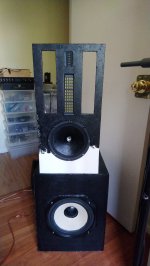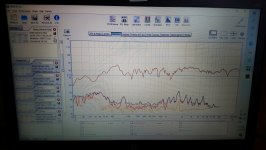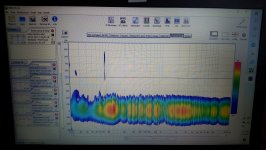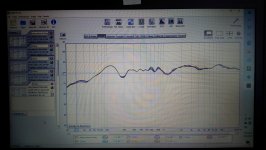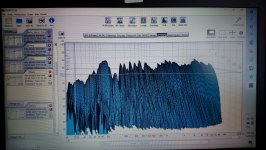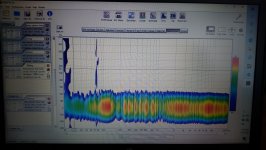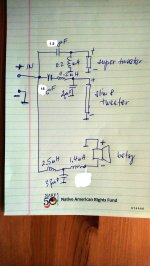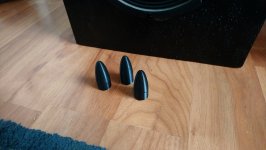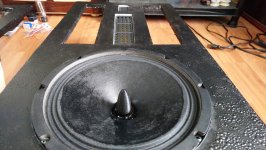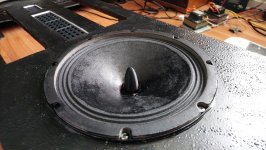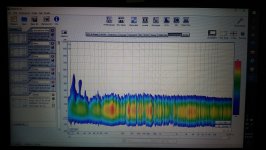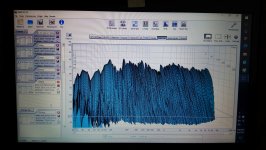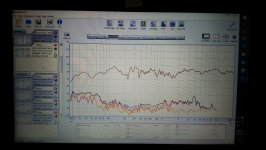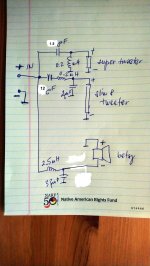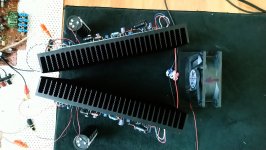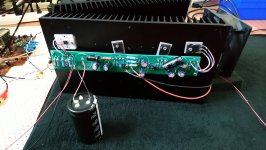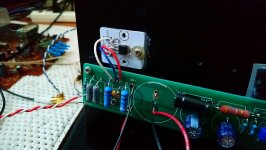That looks very interesting, adason. Where do you plan to cross the 2 planars? 4K?
Your baffle made me think of old tractors. 😀 Infinity IRS naturally is a better image.
Your baffle made me think of old tractors. 😀 Infinity IRS naturally is a better image.
Attachments
Last edited:
The drivers were a bit "shouty"
Midrange peaks are the order of the day with woofers and "midwoofers" too. Some drivers are a lot worse than others. Taming that midrange peak is always a big improvement.
That driver looks like old fashioned full range drivers back in the day. Whizzer cones were considered the hallmark of a cheap driver, but I had some old Pioneer clone 8" full range drivers with whizzer cones that really delivered! They were pretty cheap but delivered a full sound at decent volume.
I've had great success with speaker EQ, both active and passive.So I added an adjustable EQ designed by Nelson. That turned these into one of the top 3 FR drivers I've ever heard
"...but I had some old Pioneer clone 8" full range drivers with whizzer cones that really delivered! They were pretty cheap but delivered a full sound at decent volume."
The legendary BoFu???
The legendary BoFu???
They were from Lafayette, just like this.
https://www.amazon.com/GRS-Full-Ran...cphy=9021475&hvtargid=pla-1222825954934&psc=1
I had several pair and did a few different things with them.
https://www.amazon.com/GRS-Full-Ran...cphy=9021475&hvtargid=pla-1222825954934&psc=1
I had several pair and did a few different things with them.
While they do not look like the Infinity I posted above, yet, I started painting the betsy/planars speakers. Still long way to go. This is how current crossover starting point looks like. There will be some tweaking next.
Attachments
Last edited:
Measurements looks ok, promising sound so far. There is 100Hz hum, do not worry about it, its the woofer below. It relatively flat, most importantly, excellent of axis response.
There are no signs of beaming, measures almost the same up to 50 degrees of axis. Minor changes occur at crossover points, 900Hz and 9kHz, but they are rally minor, nothing that needs addressing. There is little bit more energy from slim tweeter between 2-3kHz, I may address that later. The only thing I do not like is little bit more distortion from slim grs tweeter, kind of peakish resonances, not sure what is going on there. But the distortion is purely 2nd harmonic, nothing too distractive. Speakers sound very good so far.
There are no signs of beaming, measures almost the same up to 50 degrees of axis. Minor changes occur at crossover points, 900Hz and 9kHz, but they are rally minor, nothing that needs addressing. There is little bit more energy from slim tweeter between 2-3kHz, I may address that later. The only thing I do not like is little bit more distortion from slim grs tweeter, kind of peakish resonances, not sure what is going on there. But the distortion is purely 2nd harmonic, nothing too distractive. Speakers sound very good so far.
Attachments
I'm sure this will sound like an amateur question. What does the .2mH inductor do for the super tweeter? I'm planning to add a ST to my Seas FRs. All I was planning to do is insert the cap for protection.
further tweaked the crossover
i think i am almost done
speakers sound open, clean, balanced, pleasure to listen to
lowering the cap on slim reduced distortion, not that it was noticeable before, but i just feel better if it measures fine
i think i am almost done
speakers sound open, clean, balanced, pleasure to listen to
lowering the cap on slim reduced distortion, not that it was noticeable before, but i just feel better if it measures fine
Attachments
I spent months tweaking a passive crossover for an 8" two way. More notch correction, less notch correction; more impedance correction, less impedance correction. I found that less is best with speaker correction. Making them as close to ideal as possible severely muffled the sound.
At my level of proficiency it's part science and part art. A 6 dB notch (science says 10 dB) @ 2800 Hz was 95% of the way there. Crossover is at 2 kHz so notch and impedance correction interact a lot. Correcting to 12 ohm @ 2 kHz *before* the notch was the sweet spot (very, very small correction).
After about 2 months I got the drivers to play reasonably well together. Midrange is super clear, in spite of the very audible crossover frequency of 2 kHz. The most obvious flaw is the dispersion of the drivers in the crossover range is different. That requires a waveguide to correct, which will be my next set of speakers.
At my level of proficiency it's part science and part art. A 6 dB notch (science says 10 dB) @ 2800 Hz was 95% of the way there. Crossover is at 2 kHz so notch and impedance correction interact a lot. Correcting to 12 ohm @ 2 kHz *before* the notch was the sweet spot (very, very small correction).
After about 2 months I got the drivers to play reasonably well together. Midrange is super clear, in spite of the very audible crossover frequency of 2 kHz. The most obvious flaw is the dispersion of the drivers in the crossover range is different. That requires a waveguide to correct, which will be my next set of speakers.
True, very true, when it comes to crossover, less is more. Transparency suffers when signal passes through too many passive components.
In the past, I got away in some instances with just one cap for 2-way speaker.
It this case, 4-way, its not possible.
So far, as you can see, I have very uniform of axis +/-50 degrees. And I did not bother to measure further of axis, as usually 40 degrees is enough to know what is going on.
One thing about this speaker which complicates measuring, its tall. When I place mic too close to the speaker, infront of the slim tweeter, its far from mid and super tweeter. I was placing the mic in the level between the slim and super tweeter. Hence some ripples due to the angle to the mid. Placing mic further, of course, starts including the room acoustics in the picture, which is not ideal.
But this is just for fun, so no big deal. Once I bring the speaker to the living room, they will behave better. Plus I use dsp to flatten fr response in the listening spot.
Cheers!
In the past, I got away in some instances with just one cap for 2-way speaker.
It this case, 4-way, its not possible.
So far, as you can see, I have very uniform of axis +/-50 degrees. And I did not bother to measure further of axis, as usually 40 degrees is enough to know what is going on.
One thing about this speaker which complicates measuring, its tall. When I place mic too close to the speaker, infront of the slim tweeter, its far from mid and super tweeter. I was placing the mic in the level between the slim and super tweeter. Hence some ripples due to the angle to the mid. Placing mic further, of course, starts including the room acoustics in the picture, which is not ideal.
But this is just for fun, so no big deal. Once I bring the speaker to the living room, they will behave better. Plus I use dsp to flatten fr response in the listening spot.
Cheers!
There was a time when I spent time looking at lots of speaker graphs. I noticed that typical "classic" woofers (for budget builds or replacement of older woofers) had a very smooth roll off with very small midrange resonances. They seemed to lend themselves to simple 2-way designs, with very simple crossovers.
In fact, many popular vintage speakers were designed just like this. No crossover on the woofer and just a series cap (sometimes a resistor too) on the tweeter. These speakers did not seem to suffer from crossover muddiness and they weren't shouty.
When I built a couple pairs of speakers some years back I wasn't prepared for the features of the new woofers. They work great in smaller enclosures but they are shouty. I knew they'd need crossing over but I wasn't prepared for the midrange peaks that dominated everything. It was an education and I ended up building a couple great pairs of speakers.
In fact, many popular vintage speakers were designed just like this. No crossover on the woofer and just a series cap (sometimes a resistor too) on the tweeter. These speakers did not seem to suffer from crossover muddiness and they weren't shouty.
When I built a couple pairs of speakers some years back I wasn't prepared for the features of the new woofers. They work great in smaller enclosures but they are shouty. I knew they'd need crossing over but I wasn't prepared for the midrange peaks that dominated everything. It was an education and I ended up building a couple great pairs of speakers.
just put together F3
still long way from finishing the box for it
just the heatsinks, but it works
I like the feature that you can adjust amount of distortion/character of the sound
I think I will place the trimmer on the front panel as pot
and after a series of listening tests, label certain positions for the sound character
should be fun
still long way from finishing the box for it
just the heatsinks, but it works
I like the feature that you can adjust amount of distortion/character of the sound
I think I will place the trimmer on the front panel as pot
and after a series of listening tests, label certain positions for the sound character
should be fun
Attachments
- Home
- Member Areas
- The Lounge
- viral projects, sort of


